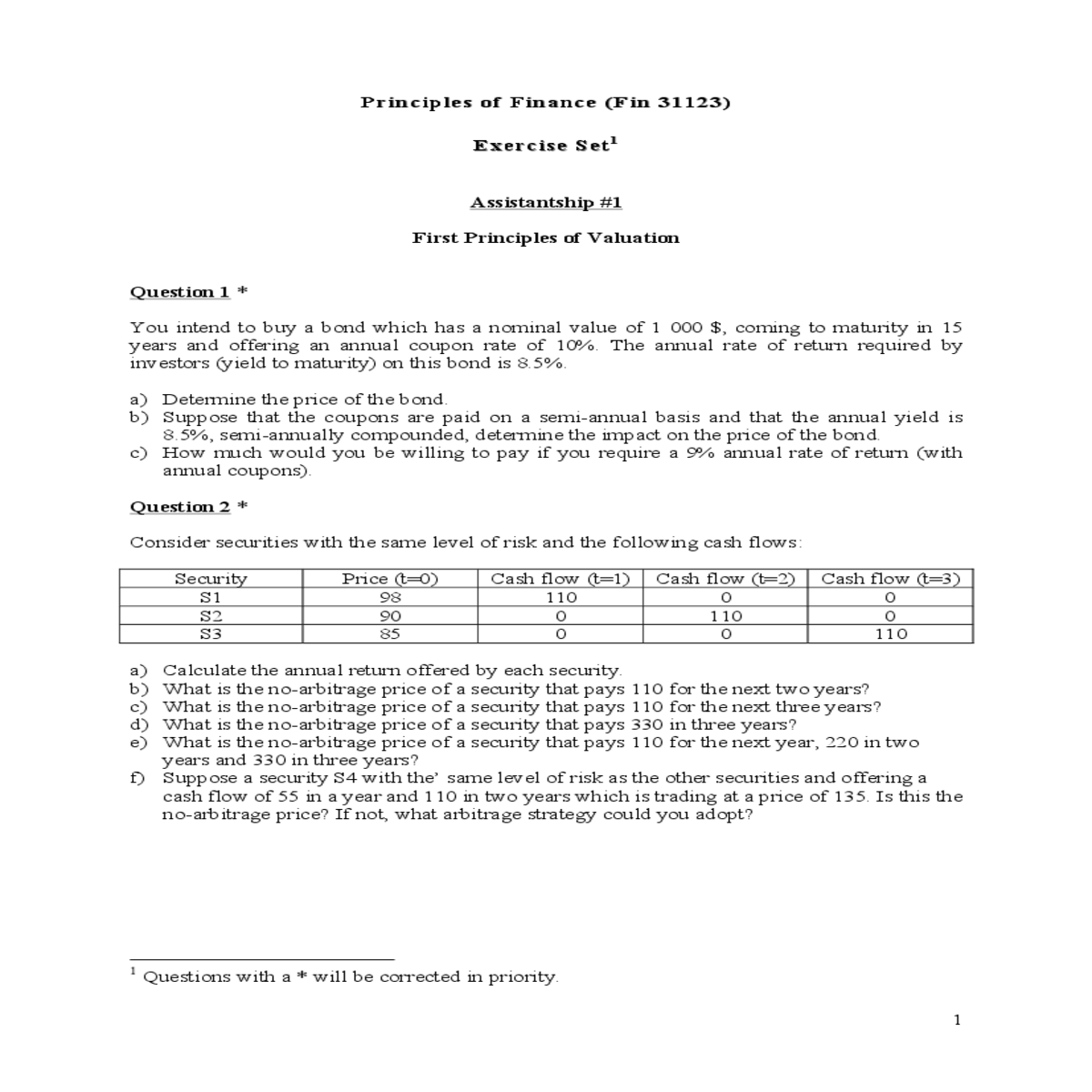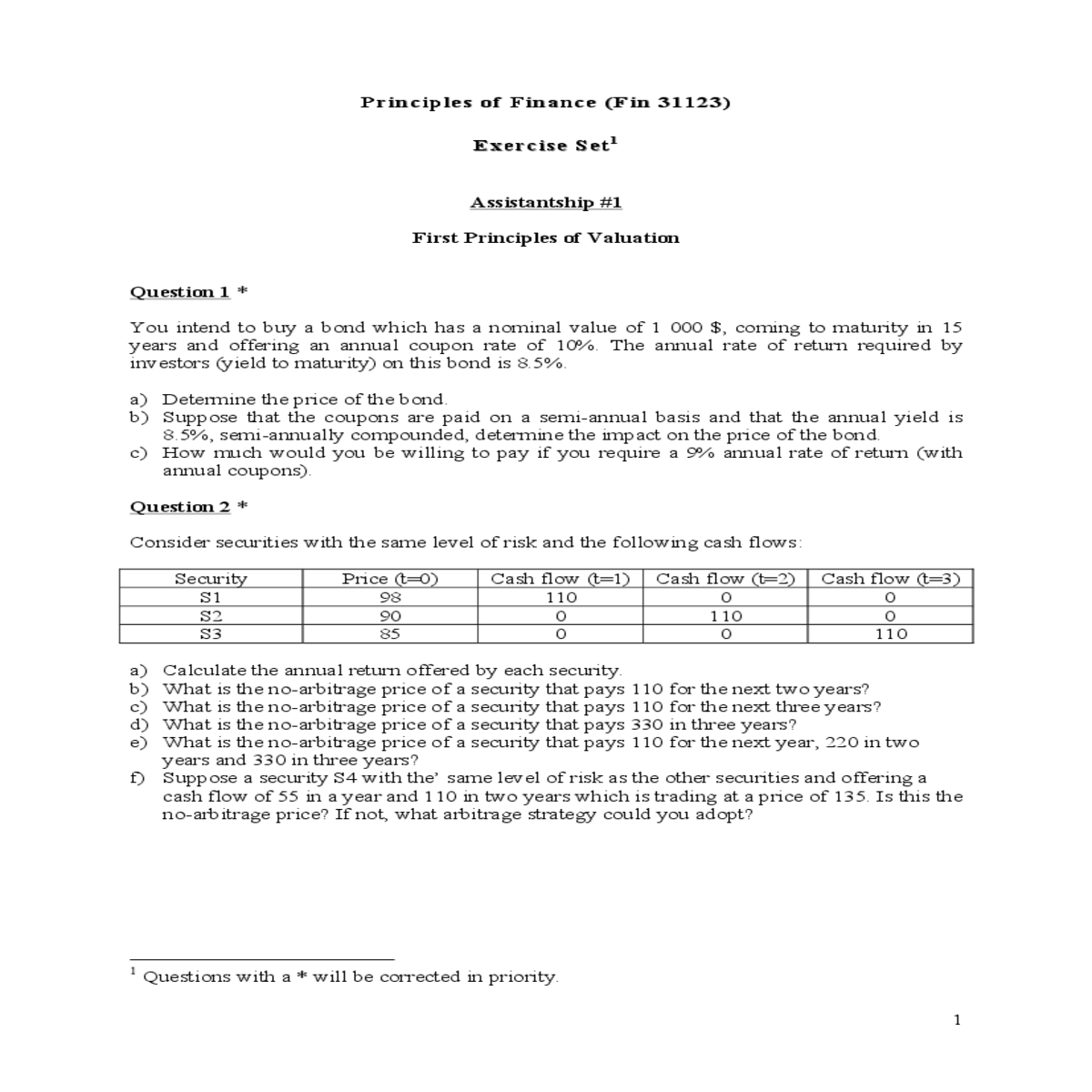Calculate the npv using the nominal irr calculated
Principles of Finance (Fin 31123)
Exercise Set11
a)Determine the price of the bond.
b)Suppose that the coupons are paid on a semi-annual basis and that the annual yield is 8.5%, semi-annually compounded, determine the impact on the price of the bond.
| Security | Price (t=0) | Cash flow (t=1) | Cash flow (t=2) | Cash flow (t=3) |
|---|---|---|---|---|
| S1 | 98 | 110 | 0 | 0 |
| S2 | 90 | 0 | 110 | 0 |
| S3 | 85 | 0 | 0 | 110 |
b)What is the no-arbitrage price of a security that pays 110 for the next two years?
c)What is the no-arbitrage price of a security that pays 110 for the next three years? d)What is the no-arbitrage price of a security that pays 330 in three years?
Question 3
a)In a recent annual reported published by ROMY Inc., specialized in the
production of cosmetics, you find the following information :
�Price of a share on 31/12/09 : 95 Euros
�Mean annual growth rate in dividends over the last 10 years : 4.3%
�Dividend paid in 2009 : 5 Euros
Based on this information, determine the expected return to
stockholders.
c)Plot the relationship between the NPV and the discount rate of both projects.
d)Determine the discount rate which leaves you indifferent between both projects.
The corporate income tax rate of XYZ is 25% and capital gains are taxed at the same rate. The cost of capital is 10%. Assuming that the projects can be repeated, what is your recommendation?
Question 3
�The EBITDA margin before depreciation is equal to 0.02 M€ per production unit. �The machine could be sold for 200 M€ at the end of year 10.
�The tax rate on profits and capital gains is equal to 50%.
Question 1*
Consider the following gamble X with its corresponding
probabilities:
a)Should John and Jack ask for the intervention of the arbitrator or is there an arrangement that would make both of them better off?
b)Would the same conclusion hold if John and Jack disagree on the probability of getting the treasure: for example, if John estimates that he has 90% chance of winning while Jack also estimates that he has 90% chance of winning the treasure?
|
|
|---|---|
|
d)Compare your results based on the notion of absolute risk aversion.
Question 4
After a long period of consultation with your psychiatrist, you realized
that your utility function is defined by: U(W) = ln (W). Your actual
level of wealth is equal to 5 000 €. a)Assume that you are facing with a
gamble whereby you can win 1 000 € with a 50% probability and lose 1 000
€ with a 50% probability. However, you can eliminate that risk by taking
an insurance at a cost of 125 €. Would you recommend buying this
insurance? b)Assume that you accept participating in the gamble
described in (a), that you lose 1 000 € and that you facing a second
time the same gamble with the possibility to insure yourself at a cost
of 125 €. Will you buy the insurance?
c)Will the agent undertake the project ?
Suppose that the agent has invested and lost his initial capital (outflow). However, he has the possibility to invest again in a project with identical characteristics as the first one.
Question 1 *
Consider an economy with 3 assets and 4 states of nature.
a)Calculate the expected return, the variance and the standard deviation in the return of each asset.
c)Using a) and b), plot the portfolio frontier.
Question 3 *
Consider an economy with a risk free asset offering a 4% return and a portfolio of risky assets (M) with an expected return of 12% and a standard deviation of 6%.
6
- Expected return E(Ri) = 15% for all assets i = 1,…., 25
Question 5
Knowing that you are currently taking a course in Financial Theory, your sister comes to you for advice on how to invest her savings. Your sister can borrow or lend at the risk free rate of 5% and the tangent portfolio (M) offers an expected return of 18.5% with a standard deviation of 13%.
| Opportunity | E(ri) | σi | ρiM |
|---|---|---|---|
| 1 | 0,06 | 1,44 | 0,10 |
| 2 | 0,20 | 0,70 | 1,00 |
| 3 | 0,30 | 1,00 | 0,40 |
| 4 | ? | ? | ? |
| M | ? | ? | ? |
| F | 0,05 | 0 | 0 |
where σi represents the standard deviation of the investment opportunity i and ρiM is the coefficient of correlation with the market portfolio.
You have the following information on the portfolio M and project 4 :
Question 2 *
Following an in-depth analysis of the stock market, in particular the market portfolio (M) and the stock of company JM, you found the following information:
| State of nature | Prob. | Market return | Return of JM |
|---|---|---|---|
| 1 | 0,1 | - 0,15 | - 0,30 |
| 2 | 0,3 | + 0,15 | + 0,00 |
| 3 | 0,4 | + 0,15 | + 0,20 |
| 4 | 0,2 | + 0,20 | + 0,50 |
8
a)Determine the beta of the efficient portfolio E
b)Determine σ (rE)
c)Determine the correlation between portfolio E and the market
portfolio, M
Question 4
After an in-depth analysis of the market, you were able to obtain the
following forecasts: - correlation between the return of the stocks of
JOJO and the market portfolio: 0.8 standard deviation of the rate of
return of JOJO: 0.25
-- standard deviation of the rate of return of the market portfolio:
0.20
How would you combine the stocks of JOJO and a risk free asset to obtain
a portfolio with a beta of 1.6?
c)For an efficient portfolio such as Q, would you advise measuring
the risk by the beta or the standard deviation? Justify your
answer
d)In the case of an individual asset (and not a portfolio), would you
advise measuring the risk by the beta or the standard deviation? Justify
your answer
9
a)Determine the payoff and net profit structure at maturity and illustrate those in a graph. b)What are the investors’ expectations behind this strategy?
10
•All options come to maturity in December.
•The price of the stock is now 93 €.
Question 6 *
Suppose that the price of a stock varies over one period following a
binomial process. In addition, you are given the following data:
Price of the stock (S) = 100
Probability that the price of the stock increases (p) = 0,40
Risk-free interest rate (rf) = 0,05
Variation rate in the price of the stock if it goes up (U) = 0,15
Variation rate in the price of the stock if it goes down (D) =
-0,10
Strike of the call on the stock: 105
a) Determine the possible evolution of the stock price over one
period.
b) Determine the possible evolution of price of the call over one period.
Capital Structure Theory
Question 1 *
Consider two firms U and L which differ only on the basis of their capital structure.
| U | L | |
|---|---|---|
| 0 | 400 | |
| 900 | ? | |
| ? | ? | |
| 18% | ? | |
|
- | 12% |
a)Calculate the value of Starlight and the value of its equity. Determine the cost of capital and the cost of equity for the firm.
b)Starlight expects to borrow 2 million € at the risk-free rate of 10%. This loan would be used to repurchase shares on the market. If the firm decides to change its capital structure, what would be the impact on the value of Starlight, the value of equity, the cost of equity and the cost of capital?
12
Both firms are leveraged, the debt ratio (proportion of debt in the firm’s capital structure) is 50% for X and 60% for Y. Except for their financial policy, X and Y are identical in all respect.
The manager also has the following information:
| State of Nature | Probability | Market return |
|
|---|---|---|---|
| 1 | 0,2 | -0,3 | 1 |
| 2 | 0,2 | 0 | 5 |
| 3 | 0,4 | 0,2 | 8 |
| 4 | 0,2 | 0,6 | 10 |
13
b)This investment is financed with 75 M€ of debt over one year and the loan is renewed every year under the same conditions, namely an annual interest rate of 4%. The remaining 25% are financed by new equity today and there is no new issue of equity for following years.
�The firm’s cash flows will grow at a constant rate of 4% after N+4 to infinity.
Determine the value of the firm on January 1st of year N.
14





